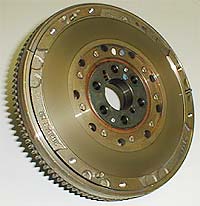From Wikipedia, the free encyclopedia
A flywheel is a rotating mechanical device that is used to store rotational energy. Flywheels have a significant moment of inertia and thus resist changes in rotational speed. The amount of energy stored in a flywheel is proportional to the square of its rotational speed. Energy is transferred to a flywheel by applying torque to it, thereby increasing its rotational speed, and hence its stored energy. Conversely, a flywheel releases stored energy by applying torque to a mechanical load, thereby decreasing the flywheel's rotational speed.
Common uses of a flywheel include:
- Providing continuous energy when the energy source is discontinuous. For example, flywheels are used in reciprocating engines because the energy source, torque from the engine, is intermittent.
- Delivering energy at rates beyond the ability of a continuous energy source. This is achieved by collecting energy in the flywheel over time and then releasing the energy quickly, at rates that exceed the abilities of the energy source.
- Controlling the orientation of a mechanical system. In such applications, the angular momentum of a flywheel is purposely transferred to a load when energy is transferred to or from the flywheel.
Carbon-composite flywheel batteries have recently been manufactured and are proving to be viable in real-world tests on mainstream cars. Additionally, their disposal is more eco-friendly.[3]
Applications
Flywheels are often used to provide continuous energy in systems where the energy source is not continuous. In such cases, the flywheel stores energy when torque is applied by the energy source, and it releases stored energy when the energy source is not applying torque to it. For example, a flywheel is used to maintain constant angular velocity of the crankshaft in a reciprocating engine. In this case, the flywheel—which is mounted on the crankshaft—stores energy when torque is exerted on it by a firing piston, and it releases energy to its mechanical loads when no piston is exerting torque on it. Other examples of this are friction motors, which use flywheel energy to power devices such as toy cars.
A flywheel may also be used to supply intermittent pulses of energy at transfer rates that exceed the abilities of its energy source, or when such pulses would disrupt the energy supply (e.g., public electric network). This is achieved by accumulating stored energy in the flywheel over a period of time, at a rate that is compatible with the energy source, and then releasing that energy at a much higher rate over a relatively short time. For example, flywheels are used in riveting machines to store energy from the motor and release it during the riveting operation.
The phenomenon of precession has to be considered when using flywheels in vehicles. A rotating flywheel responds to any momentum that tends to change the direction of its axis of rotation by a resulting precession rotation. A vehicle with a vertical-axis flywheel would experience a lateral momentum when passing the top of a hill or the bottom of a valley (roll momentum in response to a pitch change). Two counter-rotating flywheels may be needed to eliminate this effect. This effect is leveraged in reaction wheels, a type of flywheel employed in satellites in which the flywheel is used to orient the satellite's instruments without thruster rockets.
History
The principle of the flywheel is found in the Neolithic spindle and the potter's wheel.[4]The flywheel as a general mechanical device for equalizing the speed of rotation is, according to the American medievalist Lynn White, recorded in the De diversibus artibus (On various arts) of the German artisan Theophilus Presbyter (ca. 1070–1125) who records applying the device in several of his machines.[4][5]
In the Industrial Revolution, James Watt contributed to the development of the flywheel in the steam engine, and his contemporary James Pickard used a flywheel combined with a crank to transform reciprocating into rotary motion.
Physics
A flywheel with variable moment of inertia, conceived by Leonardo da Vinci.
A flywheel is a spinning wheel or disc with a fixed axle so that rotation is only about one axis. Energy is stored in the rotor as kinetic energy, or more specifically, rotational energy:
Ek=12Iω2
- ω is the angular velocity, and
I is the moment of inertia of the mass about the center of rotation. The moment of inertia is the measure of resistance to torque applied on a spinning object (i.e. the higher the moment of inertia, the slower it will spin when a given force is applied).
- The moment of inertia for a solid cylinder is
I=12mr2 , - for a thin-walled empty cylinder is
I=mr2 , - and for a thick-walled empty cylinder is
I=12m(rexternal2+rinternal2) ,[6]
When calculating with SI units, the standards would be for mass, kilograms; for radius, meters; and for angular velocity, radians per second. The resulting answer would be in joules.
The amount of energy that can safely be stored in the rotor depends on the point at which the rotor will warp or shatter. The hoop stress on the rotor is a major consideration in the design of a flywheel energy storage system.
σt=ρr2ω2
σt is the tensile stress on the rim of the cylinderρ is the density of the cylinderr is the radius of the cylinder, andω is the angular velocity of the cylinder.
σtρ=v2
σtρ is the specific tensile strength of the materialv is the tangent velocity of the rim.
Table of energy storage traits
| Flywheel purpose, type | Geometric shape factor (k) (unitless – varies with shape) |
Mass (kg) |
Diameter (cm) |
Angular velocity (rpm) |
Energy stored (MJ) |
Energy stored (kWh) |
|---|---|---|---|---|---|---|
| Small battery | 0.5 | 100 | 60 | 20,000 | 9.8 | 2.7 |
| Regenerative braking in trains | 0.5 | 3000 | 50 | 8,000 | 33.0 | 9.1 |
| Electric power backup[7] | 0.5 | 600 | 50 | 30,000 | 92.0 | 26.0 |
High-energy materials
For a given flywheel design, the kinetic energy is proportional to the ratio of the hoop stress to the material density and to the mass:Ek∝σtρm
For a given design the stored energy is proportional to the hoop stress and the volume:
Ek∝σtV
Rimmed
A rimmed flywheel has a rim, a hub, and spokes.[12] The structure of a rimmed flywheel is complex and, consequently, it may be difficult to compute its exact moment of inertia.[citation needed] A rimmed flywheel can be more easily analysed by applying various simplifications. For example:- Assume the spokes, shaft and hub have zero moments of inertia, and the flywheel's moment of inertia is from the rim alone.
- The lumped moments of inertia of spokes, hub and shaft may be estimated as a percentage of the flywheel's moment of inertia, with the remainder from the rim, so that
Irim=KIflywheel
Irim=MrimR2




